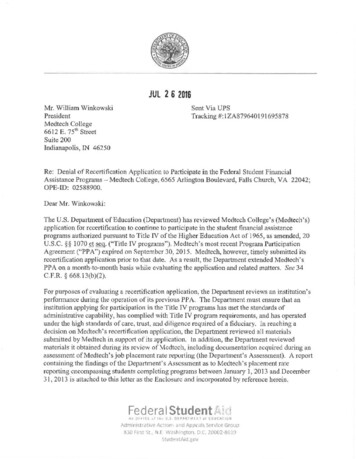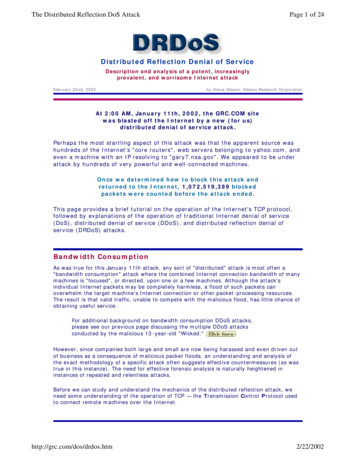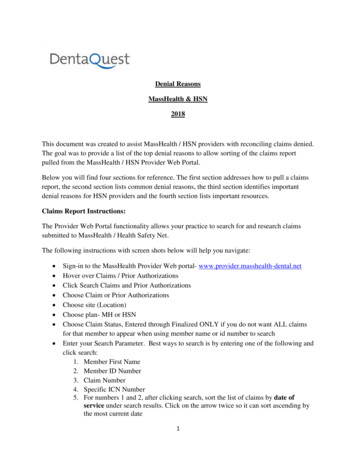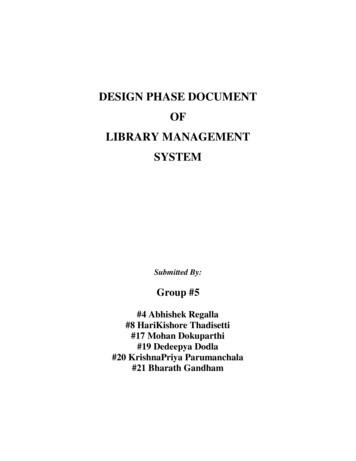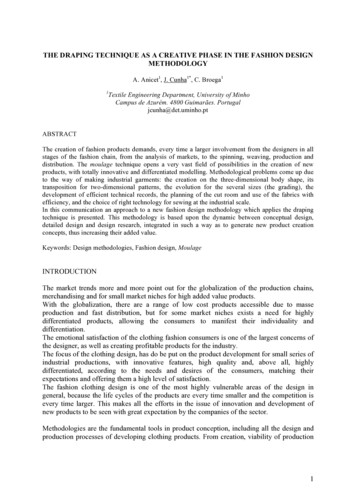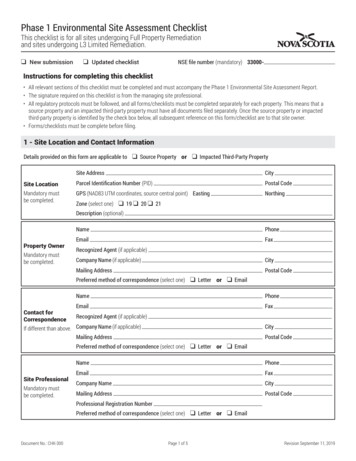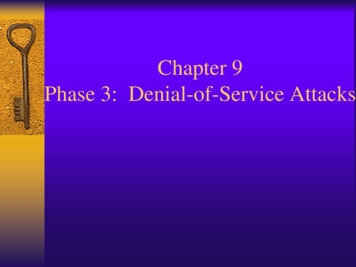
Transcription
Chapter 9Phase 3: Denial-of-Service Attacks
Fig 9.1 Denial-of-Service attack categories
Stopping Local Services Process killing (eg. inetd, httpd, named,sendmail) System reconfiguration (eg. Stop filesharing) Process crashing (eg. Stack-based bufferoverflow) Logic bomb
Defenses againstLocally Stopping Services Keep systems patched Principle of Least Privilege applied to useraccounts Run integrity-checking programs(eg.Tripwire)
Locally Exhausting Resources Filling up the process table– Achieved by forking recursively– Prevents other users from running new processes Filling up the file system– By continuously writing lots of data to file system– Prevents other users from writing to files– May causing system to crash Sending outbound traffic that fills up the networklink– By running a program that constantly sends bogusnetwork traffic– Consumes cpu cycles and network bandwidth
Defenses againstLocally Exhausting Resources Apply Principle of Least Privileges whencreating and maintaining user accounts Run system monitoring tools– Eg. Big Brother
Remotely Stopping Services viaMalformed Packet DOS Attacks Land attack– Sends a spoofed packet to target where source IP andport numbers are same as target IP and port numbers,causing network services of vulnerable target to die Latierra attack– Sends multiple Land attack packets to multiple ports Ping of Death– Sends an oversized ( 65 kB) ping packet which causesnetwork TCP/IP stack of vulnerable machines to stopworking. Jolt2 attack– Sends continuous stream of packet fragments, none ofwhich have a fragment offset of zero.– Target machine’s CPU cycle spent on packet reassembly
Remotely Stopping Services viaMalformed Packet DOS Attacks(cont.) Teardrop, Newtear, Bonk, Syndrop– Sends overlapping IP packet fragments, causing TCP/IPstacks of vulnerable machines to crash Winnuke– Sends garbage data to an open file sharing port (TCPport 139) on a Windows machine, causing thevulnerable machine to crash since data does notconform to SMB protocol Targa http://packetstorm/security.com/Dos/– Contains a suite of malformed packet DOS attacks ARP spoofing to poison router’s ARP cache usingDSniff
SSH Malformed PacketVulnerability on Cisco IOS
Defenses against RemoteStopping Services Apply system patches to fix vulnerableTCP/IP stacks and services Install anti-spoof filters on routers to thwartLand attacks Use static ARP tables to thwart ARPspoofing
Denial-of-Service Attacks thatRemotely Exhaust Resources SYN Flood Smurf Attacks Distributed Denial-of-Service Attacks
SYN Flood Attacker sends continuous stream of SYN packetsto target Target allocates memory on its connection queue tokeep track of half-open connections Attacker does not complete 3-way handshake,filling up all slots on connection queue of targetmachine If target machine has a very large connectionqueue, attacker can alternatively send sufficientamount of SYN packets to consume targetmachine’s entire network bandwidth
Fig 9.2 A SYN flood using spoofedsource IP addresses that are not live
Fig 9.3 Attackers often spoof using unresponsiveaddresses to prevent RESET from freeing up thetarget’s connection queue resources
SYN Flood Defenses Critical servers should have adequate networkbandwidth and redundant paths Use two different ISPs for Internet connectivity Install traffic shaper to limit number of SYN packets Increase the size of connection queue or lower thetimeout value to complete a half-open connection– http://www.nationwide.net/ aleph1/FAQ Use SYN cookies on Linux systems– A calculated value based on the source and destination IPaddress, port numbers, time, and a secret number– Calculated SYN cookie is loaded into the ISN of SYN-ACKresponse– no need to remember half-open connections on theconnection queue– Activated via “echo 1 /proc/sys/net/ipv4/tcp syncookies”
Fig 9.4 SYN cookies
Smurf Attacks Aka directed broadcast attacks Smurf attacks rely on an ICMP directedbroadcast to create a flood of traffic on avictim Attacker uses a spoofed source address ofvictim Smurf attack is a DOS that consumesnetwork bandwidth of victim Smurf amplifier is a network that respondsto directed broadcast messages
Fig 9.5 A Smurf attack results in a flood of the victim
Directed Broadcast Attack Tools Smurf– Creates ICMP floods Fraggle– Uses UDP instead of ICMP– Sends spoofed IP broadcast packets to a UDP port thatwill respond such as UDP port 7 (echo) Papasmurf– Uses both Smurf and Fraggle attacks List of broadcast amplifiers– http://www.netscan.org– http://www.pulltheplug.com/broadcasts2.html Use of Nmap to find broadcast amplifiers– Perform ping sweep of broadcast addresses– .BIP-hunting-namp.txt
Smurf-Attack Defenses rs/smurf.cgi Install adequate bandwidth and redundantpaths Filter ICMP messages at your border router Make sure that your network cannot be usedas a Smurf amplifier– Test via http://www.powertech.no/smurf– Insert “no ip directed-broadcast” on Ciscoborder routers
Distributed Denial-of-ServiceAttacks (DDoS) More powerful than Smurf attacks No limitation on number of machines used tolaunch attack No limitation on bandwidth that can be consumed Used against Amazon, eBay, Etrade, and Zdnet inFeb 2000 Before performing a DDOS flood, attack musttake over a large number of victim machines(zombies) and install zombie software Attacker communicates with client machineswhich in turn send commands to zombies
Fig 9.6 A DDoS attack usingTribe Flood Network 2000
DDoS Tools Tribe Flood eldraht (“barbed wire”)– Combines features of TFN and Trin00 http://packetstorm/securify.com/distributed http://mixter.warrior2k.com Description of DDOS tools– http://www.washington.edu/People/dad/
TFN2K Successor to Tribe Flood Network Allows attacker to command zombies to launchvarious attacks––––––Targa (malformed packet DoS attackUDP floodSYN floodICMP floodSmurf attack“Mix” attack using UDP, SYN, and ICMP floods Communication from client to zombies uses ICMPEcho Reply packets Zombies not detectable via Nmap Clients and zombies can spoof source IP address Very difficult to find attacker
DDoS Defenses Keep systems patched up-to-date Install adequate bandwidth, redundantpaths using different ISPs, and traffic shaper Install IDS tools that can alert you when aDDoS attack start Install egress anti-spoof filters on externalrouter to thwart DDoS zombie on yournetwork from spoofing source IP address
DDoS Defenses (cont.) Check for zombies via “Find /00-44-htm– Scans Linux and Solaris systems locallylooking for Tin00, TFN, TFN2K, Mstream,Stacheldraht, and Trinity Use Zombie Zapper to deactivate activezombies configured with default ports andpasswords– html
Run system monitoring tools – Eg. Big Brother . Remotely Stopping Services via Malformed Packet DOS Attacks Land attack – Sends a spoofed packet to target where source IP and port numbers are same as target IP and port numbers, causing network services of vulnerable target to die

